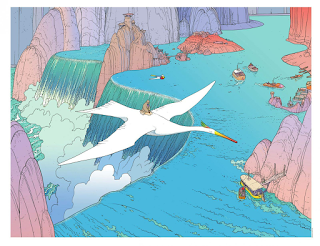Week #9
Moebius
This week, I read Blueberry by Moebius. The first reason I chose his work was that I saw the title, “Miyazaki/Moebius: A Joint Exhibition Catalogue” in the course resource page. I did not know Hayao Miyazaki collaborated with Moebius. I wanted to know how Miyazaki was influenced by Moebius’ work.
When I started reading Blueberry (The trail of the Sioux), it reminded me of the conversation I had with the members of ITEC, which is an theme park design company came to the campus last week. They had experiences of working on European theme parks; and they said, “it is surprising how popular the Old West theme is in Europe. They love cowboys and such!” Therefore, it is understandable that Blueberry is one of the most famous works by Jean Gir (Moebius). However, reading through Blueberry, I realized that the story is not similar to those generic Western themed stories; Blueberry is not a stereotypical cowboy/gunman who suddenly appears and save the town, etc…. We can see his personality and thoughts through the story.
The art style of Blueberry follows the traditional comic styles such as superhero comics; for example, the black tone is often used to create the dramatic contrast and dynamic shapes. However, Jean Gir’s lines are exceptionally fine and detailed compared to other comics (I was so impressed by his drawings of horse…!!), and this elaborate style is featured in his later works. It is interesting how he uses two names, Jean Gir and Moebius, to distinguish his different styles on works. I looked through some of the Incal as well to see the difference of Gir and Moebius. The Incal is a fantasy sci-fi, which is totally different from Blueberry; in the Incal, the imagination of Moebius is beautifully depicted with his fine etching. (Actually in Japan, the term “メビウス線” meaning Moebius line, which refers to those detailed and elaborate etching style!) As I mentioned, the style of Moebius evolves through decades; however, I feel that his exceptional sense of using colors are pretty consistent. Even in Blueberry, which is based on realistic world, he often uses complementary colors and other color theories; the use of colors maximize his beautiful drawings, creating the contrast in each panel. Within a wide range of styles/work Moebius did, the images below are some of my favorites. I like ones using imaginative colors, and the contrast of simple planes and detailed etching.
Courtesy of Google Images
Reminding of the discussion in the class, I also considered about the depiction of the Native American people in Blueberry. As they are depicted as wearing feathered clothing and war paint to their face, it can be seen that they are stereotypical design. (Since Native American’s feathered costumes are common depiction in any media, I researched a little about it…Brian Young, a Native American actor, mentions that “this kind of regalia is not meant for casual, every-day wear. For many tribes, including mine, feathers are sacred.”) However, in terms of the depiction of their facial characteristic, I feel that Moebius drew them based on the careful observation. Moreover, even American people including Blueberry are depicted pretty much based on stereotypes of the Old West. Since the stereotypes are equally used on each group, in my opinion, it can be the example of Will Eisner’s idea stating that the comics are dependent on the use of stereotype (although I do not fully agree with this opinion…).




Comments
Post a Comment